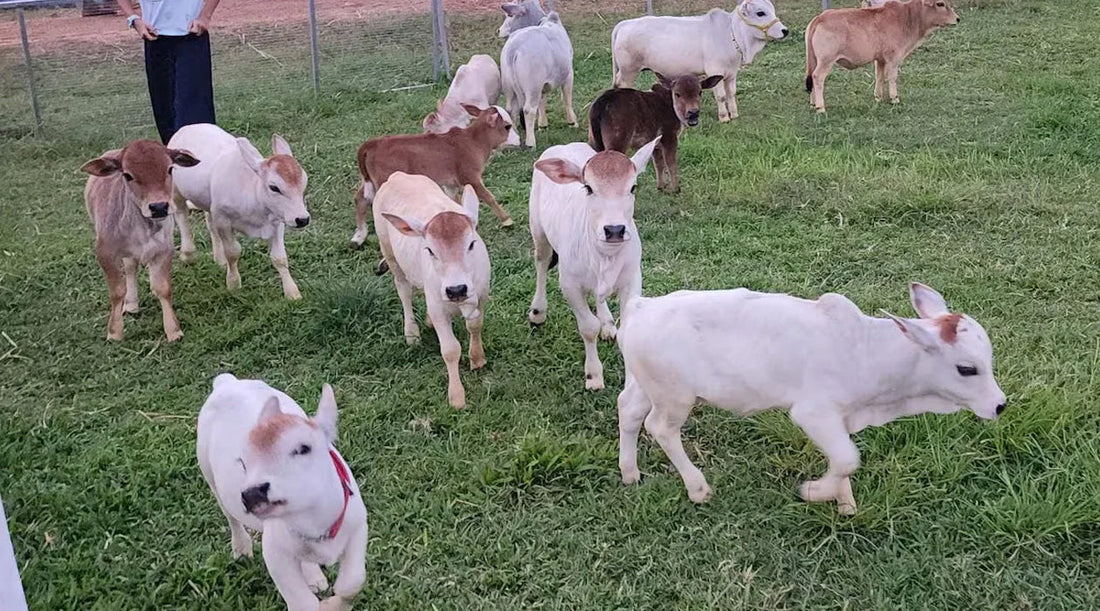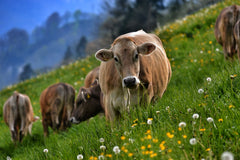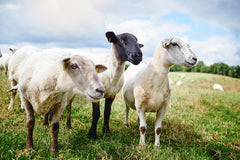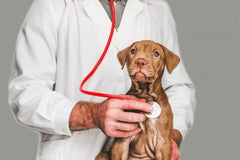
Common Disease in Punganur Cow
Punganur cows are a unique and highly valued breed originating from the Punganur region in Andhra Pradesh, India. Known for their small size, these cows are among the smallest in the world. Despite their diminutive stature, Punganur cows are prized for their high milk yield, resilience, and adaptability to the harsh climatic conditions of southern India.
These cows have distinct characteristics:
- Size: Adult Punganur cows weigh between 115-200 kg and stand about 70-90 cm tall.
- Milk Production: They produce about 3-5 liters of milk per day, which has a high fat content of around 8%.
- Adaptability: Punganur cows are well-suited to hot and dry climates, making them ideal for the semi-arid regions of Andhra Pradesh.
- Temperament: Known for their docility and ease of handling, Punganur cows are favored by small farmers
Due to their unique characteristics and adaptability, Punganur cows play a crucial role in the rural economy, providing milk and draft power. However, like all livestock, they are susceptible to various diseases that can impact their health and productivity. Understanding and managing these diseases is essential for maintaining a healthy herd and ensuring sustainable livestock farming.

Bacterial Infection In Punganur Cow
Foot and Mouth Disease (FMD)
Foot and Mouth Disease (FMD) is a severe, highly contagious viral disease that affects cloven-hoofed animals, including Punganur cows. The causative agent is the Foot-and-Mouth Disease Virus (FMDV), which belongs to the Picornaviridae family. FMD is characterized by fever and blister-like sores on the tongue, lips, and between the hooves, leading to lameness and severe discomfort.
Symptoms:
- High fever lasting 2-3 days
- Blisters and sores in the mouth and on the feet
- Excessive salivation and drooling
- Lameness and reluctance to move
- Drop in milk production
Transmission:
- Direct contact with infected animals
- Contaminated feed, water, equipment, and vehicles
- Airborne transmission over short distances, particularly in humid conditions
Prevention and Control:
- Vaccination: Regular vaccination is crucial in endemic areas. Vaccines provide immunity and help control outbreaks.
- Quarantine: Isolate new or sick animals to prevent the spread of the virus.
- Biosecurity Measures: Implement strict biosecurity protocols, including disinfection of equipment and vehicles, to prevent the introduction and spread of FMDV.
- Movement Control: Restrict the movement of animals during an outbreak to contain the virus.
Black Quarter (BQ)
Black Quarter, also known as Blackleg, is a bacterial disease caused by Clostridium chauvoei. It primarily affects young cattle, usually between 6 months and 2 years of age. The bacteria produce toxins that cause severe muscle damage and rapid death if not treated promptly.
Symptoms:
- Sudden onset of high fever
- Swelling and crepitus (crackling sound) in affected muscles, usually in the hindquarters
- Lameness and reluctance to move
- Dark, discolored areas of skin over swollen muscles
- Death within 24-48 hours in severe cases
Transmission:
- Ingestion of bacterial spores from contaminated soil or feed
- Entry of spores through wounds or abrasions
Prevention and Control:
- Vaccination: Vaccinate calves at 6 months and provide annual boosters to maintain immunity.
- Good Hygiene and Management: Maintain clean living conditions and avoid grazing in areas known to be contaminated with Clostridium spores.
- Prompt Treatment of Wounds: Treat any wounds or abrasions promptly to prevent bacterial entry.
Hemorrhagic Septicemia (HS)
HemorrhagicSepticemia is a bacterial disease caused by Pasteurella multocida, which is prevalent in tropical and subtropical regions. It leads to severe respiratory illness and septicemia, with high mortality rates in affected herds.
Symptoms:
- High fever
- Swelling of the throat, neck, and brisket
- Difficulty breathing, open-mouth breathing
- Nasal discharge, often bloody
- Sudden death in acute cases
Transmission:
- Direct contact with infected animals or carriers
- Inhalation of respiratory secretions from infected animals
Prevention and Control:
- Vaccination: Regular vaccination is essential to protect against HemorrhagicSepticemia, particularly in areas where the disease is endemic.
- Good Herd Health Practices: Maintain good hygiene, provide adequate nutrition, and reduce stress in the herd to improve overall immunity.
- Isolation: Isolate suspected cases to prevent the spread of the disease.
Viral Infection In Punganur Cow
Bovine Viral Diarrhea (BVD)
Bovine Viral Diarrhea (BVD) is a viral disease caused by the Bovine Viral Diarrhea Virus (BVDV), which affects cattle of all ages. It can lead to a range of clinical signs, from mild to severe, including respiratory and gastrointestinal symptoms, reproductive failure, and immunosuppression.
Symptoms:
- Fever
- Diarrhea, sometimes with blood
- Respiratory issues such as coughing and nasal discharge
- Ulcers in the mouth
- Decreased milk production
- Reproductive problems, including abortion and congenital defects
Transmission:
- Direct contact with infected animals
- Contaminated feed, water, and equipment
- Vertical transmission from infected cows to their calves
Prevention and Control:
- Vaccination: Vaccinate breeding animals to prevent reproductive issues and reduce the spread of the virus.
- Biosecurity: Implement strict biosecurity measures to prevent the introduction of BVDV into the herd.
- Testing and Culling: Regularly test the herd for BVDV and cull persistently infected animals to reduce viral load.
Infectious Bovine Rhinotracheitis (IBR)
Infectious Bovine Rhinotracheitis (IBR) is caused by Bovine Herpesvirus-1 (BHV-1) and primarily affects the respiratory tract. It can also cause reproductive problems and conjunctivitis.
Symptoms:
- High fever
- Nasal discharge and coughing
- Red, inflamed nasal passages (red nose)
- Conjunctivitis (pink eye)
- Abortion in pregnant cows
Transmission:
- Direct contact with infected animals
- Aerosol transmission through respiratory secretions
- Contaminated equipment and personnel
Prevention and Control:
- Vaccination: Regular vaccination helps protect against IBR and reduce the severity of outbreaks.
- Biosecurity: Implement biosecurity measures to prevent the introduction and spread of BHV-1.
- Isolation: Isolate infected animals to reduce transmission.
Bovine Respiratory Syncytial Virus (BRSV)
Bovine Respiratory Syncytial Virus (BRSV) is a significant cause of respiratory disease in cattle, particularly in young calves. The virus damages the respiratory tract, leading to severe respiratory distress and secondary bacterial infections.
Symptoms:
- Fever
- Coughing and nasal discharge
- Rapid, labored breathing
- Decreased appetite and lethargy
- Secondary bacterial pneumonia
Transmission:
- Direct contact with infected animals
- Aerosol transmission through respiratory secretions
- Contaminated equipment and personnel
Prevention and Control:
- Vaccination: Vaccinate calves to protect against BRSV and reduce the severity of respiratory disease.
- Good Management Practices: Provide proper ventilation, reduce stress, and maintain good hygiene to improve overall herd health.
- Isolation: Isolate infected animals to prevent the spread of the virus.

Internal Parasites (Worms, Flukes)
Internal parasites, including gastrointestinal worms and liver flukes, are common in Punganur cow and can significantly impact their health and productivity.
Symptoms:
- Weight loss and poor body condition
- Diarrhea
- Anemia and pale mucous membranes
- Decreased milk production
- Poor growth rates in young animals
Transmission:
- Ingestion of parasite eggs or larvae from contaminated pasture or water
Prevention and Control:
- Deworming: Regular deworming with appropriate anthelmintics based on fecal egg count monitoring.
- Pasture Management: Rotate pastures to reduce parasite load and avoid overgrazing.
- Hygiene: Maintain clean water sources and reduce fecal contamination in the environment.
External Parasites (Ticks, Lice, Mites)
External parasites, such as ticks, lice, and mites, can cause significant discomfort and health problems in Punganur cows.
Symptoms:
- Itching and scratching
- Hair loss and skin lesions
- Anemia and weight loss in severe infestations
- Transmission of other diseases (e.g., babesiosis by ticks)
Transmission:
- Direct contact with infested animals
- Environmental contamination
Prevention and Control:
- Regular Inspection: Regularly inspect animals for signs of external parasites and take appropriate action.
- Topical Treatments: Use topical insecticides and acaricides to control external parasites.
- Environmental Control: Treat the environment and housing to reduce parasite load.
Trypanosomiasis
Trypanosomiasis, also known as Surra, is a parasitic disease caused by Trypanosoma evansi, which is transmitted by biting flies. It affects the blood and various organs, leading to chronic wasting and death if untreated.
Symptoms:
- Intermittent fever
- Anemia and pale mucous membranes
- Swelling of the lymph nodes
- Weight loss and emaciation
- Weakness and lethargy
Transmission:
- Bites from infected flies, particularly Tabanid flies (horseflies) and Stomoxys (stable flies)
Prevention and Control:
- Vector Control: Implement measures to control fly populations, such as insecticide-treated nets and fly traps.
- Chemoprophylaxis: Use prophylactic drugs to prevent infection in high-risk areas.
- Regular Monitoring: Monitor animals for signs of trypanosomiasis and treat promptly.
Nutritional and Metabolic Diseases
Bloat
Bloat is a condition where gas accumulates in the rumen, leading to distension and discomfort. It can be life-threatening if not treated promptly.
Types of Bloat:
- Frothy Bloat: Caused by the ingestion of lush legumes or young cereal crops, leading to the formation of stable foam in the rumen.
- Free Gas Bloat: Caused by the inability to expel gas due to physical obstruction or motility issues.
Symptoms:
- Distended left flank
- Discomfort and restlessness
- Difficulty breathing
- Sudden death in severe cases
Ketosis
Ketosis, also known as acetonemia, is a metabolic disorder that occurs when there is an energy deficit, leading to the accumulation of ketone bodies in the blood.
Symptoms:
- Reduced appetite and milk production
- Weight loss
- Sweet-smelling breath (acetone)
- Lethargy and weakness
- Nervous signs in severe cases
Prevention and Control:
- Nutritional Management: Ensure a balanced diet with adequate energy during late gestation and early lactation. Provide propylene glycol or other energy supplements if necessary.
- Monitor Body Condition: Maintain an appropriate body condition score to avoid excessive fat mobilization.
Milk Fever (Hypocalcemia)
Milk Fever, or hypocalcemia, is a metabolic disorder caused by low blood calcium levels, usually occurring around calving.
Symptoms:
- Staggering gait and difficulty standing
- Muscle tremors and weakness
- Cold ears and dry muzzle
- Recumbency (lying down) and inability to rise
- Death if untreated
Prevention and Control:
- Diet Management: Provide a balanced diet with appropriate calcium levels during the dry period. Use low-calcium diets or anionic salts to stimulate calcium mobilization.
- Calcium Supplements: Administer oral or injectable calcium supplements around calving.
Grass Tetany (Hypomagnesemia)
Grass Tetany, or hypomagnesemia, is a metabolic disorder caused by low blood magnesium levels, typically occurring in lactating cows grazing on lush, rapidly growing pastures.
Symptoms:
- Muscle twitching and tremors
- Incoordination and staggering gait
- Aggression and excitability
- Recumbency and convulsions
- Death if untreated
Prevention and Control:
- Diet Management: Provide magnesium supplements through mineral blocks, licks, or in feed.
- Pasture Management: Avoid grazing on high-risk pastures during peak lactation periods.
Acidosis
Acidosis is a metabolic disorder caused by the overconsumption of rapidly fermentable carbohydrates, leading to a drop in rumen pH.
Symptoms:
- Decreased feed intake and weight loss
- Diarrhea
- Lethargy and depression
- Laminitis (founder) in chronic cases
- Death in severe cases
Prevention and Control:
- Diet Management: Avoid sudden changes in diet and provide adequate fiber to stimulate rumination. Gradually introduce high-energy feeds.
- Buffer Supplements: Provide bicarbonate or other buffering agents to maintain rumen pH.
- Acidosis can lead to significant production losses and health issues if not managed promptly. Proper diet management and monitoring are essential to prevent acidosis. Early detection and appropriate treatment are critical to reducing the impact of the disease.

Reproductive Diseases In Panganur Cow
Metritis
Metritis is an inflammation of the uterus that typically occurs after calving due to bacterial infection.
Symptoms:
- Foul-smelling vaginal discharge
- Fever
- Reduced appetite and milk production
- Depression and lethargy
Prevention and Control:
- Hygiene: Maintain clean calving environments and practice good hygiene during and after calving.
- Nutrition: Provide balanced nutrition to support immune function.
Retained Placenta
Retained Placenta is a condition where the placenta fails to be expelled within 24 hours after calving.
Symptoms:
- Presence of the placenta hanging from the vulva
- Foul-smelling discharge
- Fever and reduced appetite in severe cases
Prevention and Control:
- Nutritional Management: Provide adequate nutrition during pregnancy to support placental health.
- Monitor Calving: Monitor cows during calving and provide assistance if necessary.
Mastitis in Lactating Cows
Mastitis is an inflammation of the mammary gland, typically caused by bacterial infections. It affects milk production and quality.
Symptoms:
- Swelling, redness, and heat in the udder
- Pain and discomfort
- Clotted or discolored milk
- Reduced milk yield
Transmission:
- Contamination during milking
- Poor hygiene and milking practices
Prevention and Control:
- Hygiene: Maintain strict hygiene during milking and clean the udder before and after milking.
- Regular Screening: Screen for early detection and treatment of subclinical mastitis.
- Proper Milking Techniques: Ensure proper milking techniques and equipment maintenance.
Prolapse (Uterine and Vaginal)
Prolapse is the displacement of the uterus or vagina, typically occurring around calving due to excessive straining or weakened pelvic support structures.
Symptoms:
- Protrusion of the uterus or vagina through the vulva
- Swelling and discomfort
- Difficulty standing and walking
Prevention and Control:
- Monitor Calving: Monitor cows during calving and provide assistance if necessary.
- Nutrition: Provide balanced nutrition to support pelvic health and reduce the risk of prolapse.
Infertility Issues
Infertility can be caused by various factors, including nutritional deficiencies, infections, and management practices.
Symptoms:
- Failure to conceive after repeated breeding attempts
- Irregular estrous cycles
- Early embryonic loss
Prevention and Control:
- Nutritional Management: Provide balanced nutrition to support reproductive health.
- Herd Health: Maintain good herd health and hygiene to reduce the risk of infections.
- Breeding Management: Implement proper breeding management practices, including timing of insemination and use of proven sires.
Preventive Measures and General Health Management
Vaccination Schedules
Implementing a regular vaccination schedule is essential to protect Punganur cows from infectious diseases. Work with a veterinarian to develop a comprehensive vaccination plan tailored to your herd’s specific needs.
Common Vaccines:
- Foot and Mouth Disease (FMD)
- HemorrhagicSepticemia (HS)
- Black Quarter (BQ)
- Bovine Viral Diarrhea (BVD)
- Infectious Bovine Rhinotracheitis (IBR)
Schedule:
- Calves: Start vaccinations at 3-4 months of age.
- Adults: Provide annual boosters as recommended by a veterinarian.
Regular Health Check-ups
Regular health check-ups are essential to monitor the overall health and well-being of Punganur cows.
Components of Health Check-ups:
- Physical examination
- Body condition scoring
- Monitoring of vital signs
- Blood and fecal tests for parasites and diseases
Frequency:
- Perform health check-ups at least twice a year.
- Increase frequency during high-risk periods, such as calving and lactation.
Proper Nutrition
Proper nutrition is crucial for maintaining the health and productivity of Punganur cows.
Components of a Balanced Diet:
- Adequate energy, protein, vitamins, and minerals
- Roughage to stimulate rumination and prevent digestive issues
- Clean, fresh water at all times
Nutritional Management:
- Provide a balanced diet tailored to the cows’ life stage and production level.
- Supplement with minerals and vitamins as needed.
- Monitor body condition and adjust feeding accordingly.
Hygiene and Housing Management
Maintaining proper hygiene and housing conditions is essential to prevent diseases and ensure the well-being of Punganur cows.
Housing Management:
- Provide clean, dry, and well-ventilated housing.
- Ensure adequate space for each animal to reduce stress and overcrowding.
- Implement regular cleaning and disinfection protocols.
Hygiene Practices:
- Maintain clean feeding and watering equipment.
- Practice good milking hygiene to prevent mastitis.
- Isolate sick animals to prevent the spread of disease.
Biosecurity Measures
Implementing biosecurity measures is essential to prevent the introduction and spread of infectious diseases in the herd.
Key Biosecurity Measures:
- Control access to the farm and restrict entry of unauthorized personnel.
- Quarantine new animals before introducing them to the herd.
- Implement strict hygiene protocols for equipment and vehicles.
- Monitor and manage wildlife and pests that can transmit diseases..
Homeopathic Solutions For Punganur Cow

MILKOGEN KIT for Increasing Milk in Punganur Cow
MILKOGEN Kit is an excellent Homeopathic Veterinary Medicine used in Cows and Buffaloes to increase milk yield naturally. It is a natural replacer of oxytocin hormone without any contraindications or side effects but with a definite increase in the milk yield. It increases the milk quantity and fat percentage of the milk to the full potential of an animal.
TEATASULE FIBRO GOLD KIT For Mastities Issue In Punganur Cow
TEATASULE FIBRO GOLD KIT is the best Homeopathic Veterinary Medicine for female animals in the case of chronic and clinical mastitis. TEATASULE FIBRO GOLD KIT is very effective in case of chronic or clinical mastitis when the udder is as hard as a stone, teats are shrunk with fibroids developed in the teats, and in teat cracks.
Marigold+ LSD-25 Kit For Lumpy Skin Diseases
Marigold+ LSD-25 Kit is For boosting immunity against LSD and other similar viral diseases. It is a Homeopathic Treatment of Lumpy Skin Disease (LSD) in cattle with oral medicine for enhancing internal Immunity and Healing Spray for treating external wounds.
Pyrosule-XP for High Fever in Cattle
PYROSULE-XP for CATTLE is the best Homeopathic Veterinary Medicine for Cattle that protects animals from infection. PYROSULE-XP relieves muscular and nervous pain that occurs during a fever and even decreases the severity of the fever.

FOOMASULE NO. 2 for Foot and Mouth Disease
FOOMASULE No. 2 is the best available Homeopathic Veterinary Medicine for treating FOOT & MOUTH DISEASE (FMD) in cattle. It is effective against all strains of FMD virus. It cures the lesions in the mouth within 24 hours and helps the animal in grazing.

ProlapsGo For Prolaps Problem In Cattle
PROLAPSGO for cattle is the best Homeopathic Veterinary Medicine for Pre-partum or Post-partum prolapse of the uterus in cows & buffaloes. PROLAPSGO gives fast and long-lasting relief in case of prolapse of the uterus in cows and buffaloes. It can be sprayed directly over the prolapse of the uterus and can also be administered orally.
R.Bloatasule-XP For Bloating Issue in Cattle
R. BLOATASULE XP is the best Homeopathic Veterinary Medicine that is helpful for the treatment of indigestion, anorexia, and liver disorders.












